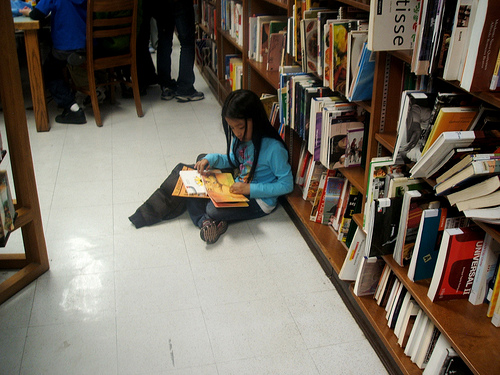The Death of Picture Books?

Earlier this year, The New York Times carried an article that suggested that picture books were no longer a staple for children. Is this true? Do you buy picture books for your children or do you skip straight to books which have more text?
The economic downturn is certainly a major factor, but many in the industry see an additional reason for the slump. Parents have begun pressing their kindergartners and first graders to leave the picture book behind and move on to more text-heavy chapter books. Publishers cite pressures from parents who are mindful of increasingly rigorous standardized testing in schools.“They’re 4 years old, and their parents are getting them ‘Stuart Little,’ ” said Dara La Porte, the manager of the children’s department at the Politics and Prose bookstore in Washington. “I see children pick up picture books, and then the parents say, ‘You can do better than this, you can do more than this.’ It’s a terrible pressure parents are feeling — that somehow, I shouldn’t let my child have this picture book because she won’t get into Harvard.”
Read the entire article here.
The evidence: BookScan figures show that last year, picture books represented 10.8% of the overall children’s market—virtually the same as in 2005, when they represented 10.7%. “For us right now, picture books are still vibrant and thriving,” said HarperCollins Children’s Books president Susan Katz.The story also overlooked Ben Franklin’s brainchild: libraries. “They were looking at it from the perspective of booksellers as opposed to libraries,” said Karen MacPherson, the children and youth services coordinator at Takoma Park Library in Maryland and a writer for Scripps. In her children’s section, picture books are “very popular”—a close second to graphic novels when it comes to circulation.Just what is going on with children’s picture books? The true story is more complicated, involving the cyclical nature of the economy, the strong interest in picture books in public libraries, and the changing retail market.Many in the industry pointed out that kids read picture books over and over. “If you think of it in business terms, when you amortize your investment, they turn out to be inexpensive,” said children’s book historian Leonard Marcus.That’s one reason some booksellers say they’re still able to move picture books, just fewer of them, even in a bad economy. “Instead of somebody buying six, they’re buying three,” said Sally Oddi, owner and manager of Cover to Cover Book Store in Columbus, Ohio.The pressure to get kids to read at a young age is unfortunate, said Ken Marantz, an emeritus professor of art education at Ohio State. “It’s skipping a whole evolutionary chapter in the child’s life.”In fact, picture books exercise kids’ brains in a different way than text-only books. “There’s no other art form where pictures and words are completely interdependent on one another,” Bluemle said. “An illustrated storybook can stand on its own when read aloud, but a true picture book needs both.”
Read the entire article here.









